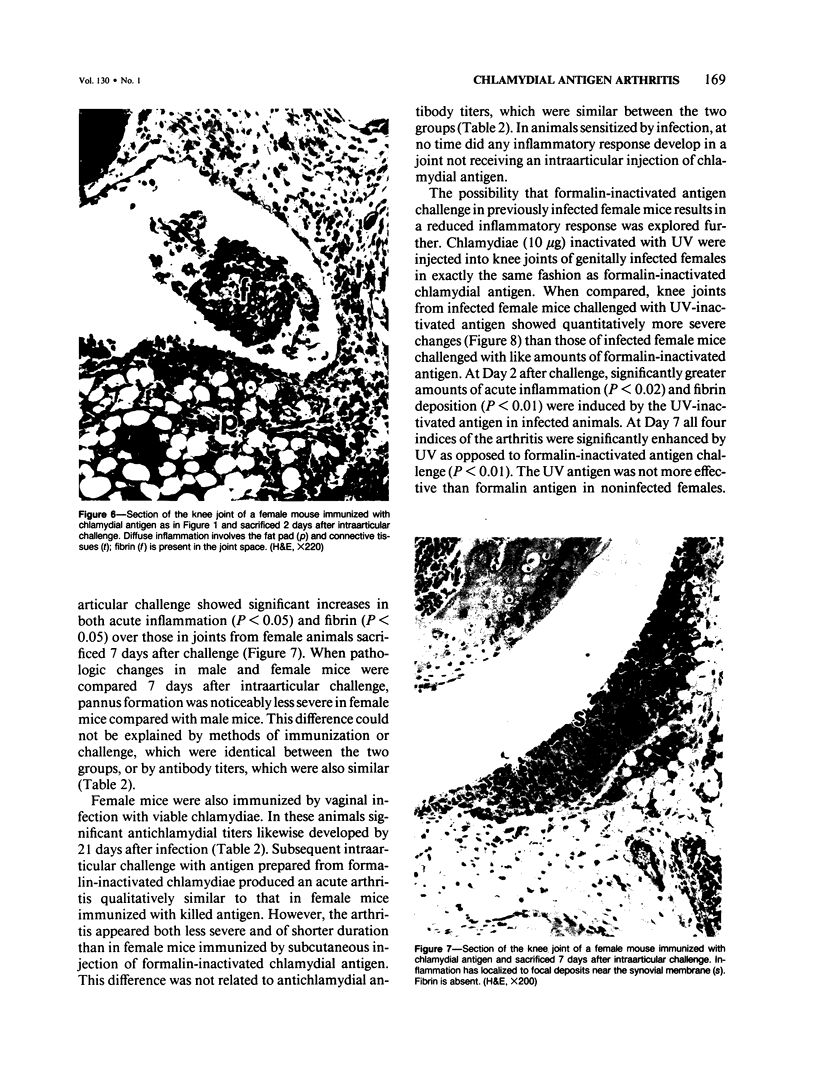Abstract
Antigen from a Chlamydia trachomatis biovar, mouse pneumonitis agent (MoPn), was used to produce an inflammatory arthritis by inoculation in the knee joints of C57B1/6 mice. The production of arthritis was strongly dependent on prior sensitization to chlamydiae by subcutaneous immunization in either sex or genital infection in females. In unimmunized animals quantitatively less inflammation, fibrin exudation, and pannus formation developed than in immunized counterparts. In neither uninjected nor McCoy or HeLa Cell antigen-treated joints did arthritis develop. The arthritis produced was more pronounced at 7 than at 2 days after intraarticular challenge and showed minimal residual changes at 21 days. Residual changes included subsynovial hyperplasia. In genitally infected female mice less severe arthropathy developed than in subcutaneously immunized female mice after intraarticular challenge with formalin-inactivated chlamydial antigen. However, in infected mice challenged with chlamydiae inactivated by ultraviolet irradiation a severe arthritis with destructive pannus developed, suggesting alteration of antigenicity by formalin inactivation. The strong association of the arthritis with the presence of chlamydial antibody suggests its use as a model of human Reiter's disease in which prior sensitization to Chlamydia is an important factor.
Full text
PDF









Images in this article
Selected References
These references are in PubMed. This may not be the complete list of references from this article.
- Brackertz D., Mitchell G. F., Mackay I. R. Antigen-induced arthritis in mice. I. Induction of arthritis in various strains of mice. Arthritis Rheum. 1977 Apr;20(3):841–850. doi: 10.1002/art.1780200314. [DOI] [PubMed] [Google Scholar]
- Caldwell H. D., Kromhout J., Schachter J. Purification and partial characterization of the major outer membrane protein of Chlamydia trachomatis. Infect Immun. 1981 Mar;31(3):1161–1176. doi: 10.1128/iai.31.3.1161-1176.1981. [DOI] [PMC free article] [PubMed] [Google Scholar]
- Cutlip R. C., Ramsey F. K. Ovine chlamydial polyarthritis: sequential development of articular lesions in lambs after intraarticular exposure. Am J Vet Res. 1973 Jan;34(1):71–75. [PubMed] [Google Scholar]
- Ellens D. J., Gielkens A. L. A simple method for the purification of 5-aminosalicylic acid. Application of the product as substrate in enzyme-linked immunosorbent assay (ELISA). J Immunol Methods. 1980;37(3-4):325–332. doi: 10.1016/0022-1759(80)90318-x. [DOI] [PubMed] [Google Scholar]
- Espinoza L. R., Vasey F. B., Gaylord S. W., Dietz C., Bergen L., Bridgeford P., Germain B. F. Histocompatibility typing in the seronegative spondyloarthropathies: a survey. Semin Arthritis Rheum. 1982 Feb;11(3):375–381. doi: 10.1016/0049-0172(82)90058-0. [DOI] [PubMed] [Google Scholar]
- Ford D. K., da Roza D., Schulzer M. Lymphocytes from the site of disease but not blood lymphocytes indicate the cause of arthritis. Ann Rheum Dis. 1985 Oct;44(10):701–710. doi: 10.1136/ard.44.10.701. [DOI] [PMC free article] [PubMed] [Google Scholar]
- Howson P., Shepard N., Mitchell N. The antigen induced arthritis model: the relevance of the method of induction to its use as a model of human disease. J Rheumatol. 1986 Apr;13(2):379–390. [PubMed] [Google Scholar]
- Keat A. C., Thomas B. J., Taylor-Robinson D., Pegrum G. D., Maini R. N., Scott J. T. Evidence of Chlamydia trachomatis infection in sexually acquired reactive arthritis. Ann Rheum Dis. 1980 Oct;39(5):431–437. doi: 10.1136/ard.39.5.431. [DOI] [PMC free article] [PubMed] [Google Scholar]
- Keat A., Thomas B. J., Taylor-Robinson D. Chlamydial infection in the aetiology of arthritis. Br Med Bull. 1983 Apr;39(2):168–174. doi: 10.1093/oxfordjournals.bmb.a071811. [DOI] [PubMed] [Google Scholar]
- Koga T., Kakimoto K., Hirofuji T., Kotani S., Ohkuni H., Watanabe K., Okada N., Okada H., Sumiyoshi A., Saisho K. Acute joint inflammation in mice after systemic injection of the cell wall, its peptidoglycan, and chemically defined peptidoglycan subunits from various bacteria. Infect Immun. 1985 Oct;50(1):27–34. doi: 10.1128/iai.50.1.27-34.1985. [DOI] [PMC free article] [PubMed] [Google Scholar]
- Kousa M., Saikku P., Richmond S., Lassus A. Frequent association of chlamydial infection with Reiter's syndrome. Sex Transm Dis. 1978 Apr-Jun;5(2):57–61. doi: 10.1097/00007435-197804000-00004. [DOI] [PubMed] [Google Scholar]
- Kruijsen M. W., van den Berg W. B., van de Putte L. B. Sequential alterations of periarticular structures in antigen-induced arthritis in mice. Histological observations on fibrous capsule, ligaments, bone and muscles, using whole joint sections. Br J Exp Pathol. 1983 Jun;64(3):298–305. [PMC free article] [PubMed] [Google Scholar]
- Levy N. J., Muñoz A., McCormack W. M. Enzyme-linked immunosorbent assay for the detection of antibody to Chlamydia trachomatis and Chlamydia psittaci. J Lab Clin Med. 1983 Dec;102(6):918–925. [PubMed] [Google Scholar]
- Martin D. H., Pollock S., Kuo C. C., Wang S. P., Brunham R. C., Holmes K. K. Chlamydia trachomatis infections in men with Reiter's syndrome. Ann Intern Med. 1984 Feb;100(2):207–213. doi: 10.7326/0003-4819-100-2-207. [DOI] [PubMed] [Google Scholar]
- Smith D. E., James P. G., Schachter J., Engleman E. P., Meyer K. F. Experimental bedsonial arthritis. Arthritis Rheum. 1973 Jan-Feb;16(1):21–29. doi: 10.1002/art.1780160104. [DOI] [PubMed] [Google Scholar]
- Tuffrey M., Falder P., Thomas B., Taylor-Robinson D. The distribution and effect of Chlamydia trachomatis in CBA mice inoculated genitally, intra-articularly or intravenously. Med Microbiol Immunol. 1984;173(1):29–35. doi: 10.1007/BF02123566. [DOI] [PubMed] [Google Scholar]
- Yu D. T., Ogasawara M., Hill J. L., Kono D. H. Study of Reiter's syndrome, with special emphasis on Yersinia enterocolitica. Immunol Rev. 1985 Aug;86:27–45. doi: 10.1111/j.1600-065x.1985.tb01136.x. [DOI] [PubMed] [Google Scholar]









